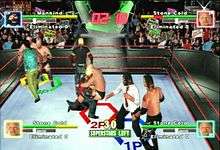WWF Royal Rumble (2000 video game)
WWF Royal Rumble is a professional wrestling video game released in 2000 for arcades and the Dreamcast. THQ published the title for the Dreamcast while Sega released it for arcades. It is based on the World Wrestling Federation (WWF) professional wrestling promotion and its yearly Royal Rumble event.[2] Yuke's, creators of the WWF SmackDown! series developed Royal Rumble, which had several unique features including support for up to nine wrestlers on the screen simultaneously.[3]
| WWF Royal Rumble | |
|---|---|
 Arcade flyer art featuring Stone Cold Steve Austin and The Rock. | |
| Developer(s) | Sega Yuke's |
| Publisher(s) | THQ Yuke's (Japan release)[1] Sega (arcade distribution) |
| Platform(s) | Arcade Dreamcast |
| Release | |
| Genre(s) | Fighting, Sports |
| Mode(s) | Single player, Multiplayer |
| Cabinet | Standard upright, two-screen version |
| Arcade system | Sega NAOMI |
| CPU | Hitachi SH-4 128-bit RISC @200 MHz |
| Sound | ARM7 Yamaha AICA @45 MHz |
| Display | Raster, medium resolution |
The Dreamcast version was released to mixed reviews that faulted its small roster and lack of gameplay modes.
Gameplay

The game has two modes, Exhibition and Royal Rumble. In Exhibition mode, the player chooses a wrestler along with a partner and wrestles a series of singles matches. The player's partner can interfere on the player's behalf on command. These partner moves can be used any number of times during the match, but must be recharged before they can be used again. The object of each match is to wear down the opponent using various attacks and grappling maneuvers, decreasing their life bar before ending the match by pinfall or knockout.[4]
Royal Rumble mode involves a multi-wrestler match in which the player must eliminate a certain number of opponents from the match within a time limit by sending them over the top rope and onto the floor. Eliminating opponents adds more time to the player's clock; eliminating larger wrestlers offers a higher time bonus. Due to size of the game's roster, wrestlers appear multiple times in the same Royal Rumble match.[4]
Each player has a super meter that fills up during the course of the match. When it fills up, the player receives an "S" icon, which can be used to instantly recover from pin attempts in Exhibition mode or re-enter the ring during a Royal Rumble match.[4]
This was Big Show's only video game appearance with the 2000 roster, as he was removed from WWF SmackDown! 2: Know Your Role and WWF No Mercy due to his demotion to Ohio Valley Wrestling. Coincidentally, he returned at the following year's Royal Rumble. Kurt Angle and Tazz (who debuted in a match against Angle on the 2000 edition of the titular pay-per-view) made their first WWF video game debuts in this game, before No Mercy and SmackDown! 2.
Reception
| Reception | ||||||||||||||||||||||||||||||
|---|---|---|---|---|---|---|---|---|---|---|---|---|---|---|---|---|---|---|---|---|---|---|---|---|---|---|---|---|---|---|
| ||||||||||||||||||||||||||||||
Daniel Erickson reviewed the Dreamcast version of the game for Next Generation, rating it three stars out of five, and stated that "It's neither deep nor revolutionary, but it's a whole lot of fun."[11]
The Dreamcast version received "average" reviews according to video game review aggregator Metacritic.[5]
One of the biggest criticisms was of the small number of playable characters, which IGN called "paper thin" and GameSpot's Jeff Gerstmann called "confining." The game's lack of modes was also criticized. IGN recommended other Japanese Dreamcast wrestling titles such as Toukon Retsuden and Giant Gram over Royal Rumble.[3][4] The earliest review came from PlanetDreamcast, which gave it a low score of four out of ten over a month before the game was released.[10] In Japan, Famitsu gave it a score of 30 out of 40.[1]
References
- "ドリームキャスト - WWF ROYALRUMBLE". Famitsu. 915: 53. 30 June 2006.
- "WWF Royal Rumble (Arcade)". Killer List of Videogames. Retrieved 28 February 2015.
- Dunham, Jeremy (15 August 2000). "WWF Royal Rumble (DC)". IGN. Retrieved 8 February 2013.
- Gerstmann, Jeff (14 August 2000). "WWF Royal Rumble Review (DC)". GameSpot. Retrieved 28 February 2015.
- "WWF Royal Rumble for Dreamcast Reviews". Metacritic. Retrieved 28 February 2015.
- Ottoson, Joe. "WWF Royal Rumble (DC) - Review". AllGame. Archived from the original on 15 November 2014. Retrieved 28 February 2015.
- Key, Steve (2000). "Dreamcast Review: WWF Royal Rumble". Computer and Video Games (Official Dreamcast Magazine UK). Archived from the original on 24 June 2007. Retrieved 28 February 2015.
- "WWF Royal Rumble (DC)". Electronic Gaming Monthly. 2000.
- The D-Pad Destroyer (15 August 2000). "WWF Royal Rumble Review for Dreamcast on GamePro.com". GamePro. Archived from the original on 7 February 2005. Retrieved 28 February 2015.
- Mr. Domino (3 July 2000). "WWF Royal Rumble". PlanetDreamcast. Archived from the original on 25 January 2009. Retrieved 28 February 2015.
- Erickson, Daniel (October 2000). "Finals". Next Generation. Vol. 3 no. 10. Imagine Media. p. 113.
- Boyce, Ryan (4 August 2000). "WWF Royal Rumble (DC)". Maxim. Archived from the original on 26 June 2001. Retrieved 28 February 2015.